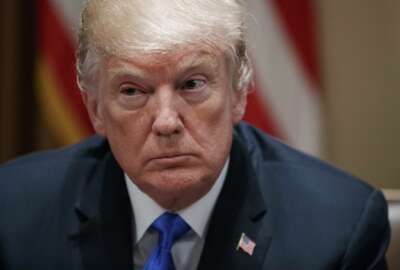
Hubbard Radio Washington DC, LLC. All rights reserved. This website is not intended for users located within the European Economic Area.
Hubbard Radio Washington DC, LLC. All rights reserved. This website is not intended for users located within the European Economic Area.
President Donald Trump's fiscal 2019 budget request includes several other recommendations that would change current retirement, health and other benefits for f...
Subscribe to Federal Drive’s daily audio interviews on iTunes or PodcastOne.
The White House is proposing a pay freeze for federal civilian employees in 2019, among other significant changes to the way it rewards top performers, hands out retirement and health benefits and administers annual leave.
“Across the board pay increases have long-term fixed costs, yet fail to address existing pay disparities, or target mission critical recruitment and retention goals,” President Donald Trump’s 2019 budget proposal reads. “The administration therefore proposes a pay freeze for federal civilian employees for 2019.”
Members of the military would receive a 2.6 percent raise, according to the 2019 document.
Senate Homeland Security and Governmental Affairs Committee Ranking Member Claire McCaskill (D-Mo.) had previously announced in December that she had learned about the possibility of a pay freeze for civilian workers next year from a preliminary budget document.
Though the president is proposing a pay freeze for civilian employees next year, Congress has multiple opportunities to suggest and pass law that says otherwise.
An annual across-the-board pay adjustment formula in the Federal Employees Pay Comparability Act typically sets raises for most federal employees under the General Schedule.
According to that formula, federal employees should receive a 2 percent average base pay raise next year, and that’s before any additional locality pay adjustments.
The president can choose to differ from this formula, as he just did with his 2019 request. Congress can ultimately propose and pass any alternative numbers in its annual appropriations or omnibus spending bills.
The National Active and Retired Federal Employees Association (NARFE) encouraged lawmakers to consider their own pay proposal for civilian employees.
“This budget singles out federal workers by implementing a pay freeze, which is perplexing given the president’s continual praise of the strong economy and rising wage growth,” NARFE National President Richard Thissen said in a statement Monday afternoon. “Denying a modest pay raise during a time of economic prosperity demonstrates disdain for federal workers and needlessly punishes middle-class households.”
Several lawmakers this year already introduced and sponsored legislation, the Federal Adjustment of Incomes Rates (FAIR) Act, which would give federal employees a 3 percent raise in 2019.
But at the very least, Monday’s 2019 request details the Trump administration’s thinking and overall mindset for managing and compensating the federal workforce, and it will likely drive the policy discussions in the coming year.
The budget proposal is littered with recommendations on the federal workforce. Some are broad, sweeping suggestions.
Citing last year’s Congressional Budget Office study on federal compensation, the White House describes a system that has “long term, fixed” and “significant” costs to employ the federal workforce. Those costs, according to CBO, are an average of 17 percent higher than what the private sector spends to compensate its workers.
“This administration believes in pay for performance,” the budget reads. “The existing federal salary structure rewards longevity over performance. This is most evident in the tenure-based ‘step-increase’ promotions that white collar workers receive on a fixed, periodic schedule without regard to whether they are performing at an exceptional level or merely passable.”
The Trump administration is proposing to the “slow the frequency” of step increases in the General Schedule and increase “performance-based pay” for employees in mission-critical occupations.
The General Schedule, and the broader federal personnel system, are relics of an earlier time, the administration said. The 40-year-old Civil Service Reform Act of 1978 is inadequate for today’s modern workforce, the White House added.
“The administration also intends to partner with Congress to cull statutory and regulatory rules that have over time created an increasingly incomprehensible and unmanageable civil service system,” the budget said. “The administration will propose changes in hiring and dismissal procedures to empower federal managers with greater flexibility. Agency managers will be encouraged to restore management prerogatives that have been ceded to federal labor unions and create a new partnership with these entities that maintains the primacy of each agency’s obligation to efficiently and effectively accomplish its public mission.”
The president’s request, however, provides few details on how exactly the administration plans to implement performance-based pay.
Other recommendations are more specific.
For example, the White House proposes the creation of a $50 million central fund that would pay for innovation ideas to help meet recruitment, retention and reskilling challenges across government.
The President’s Management Council would select a board of “federal officials to manage the fund, which would review and select from among the agency and cross-agency proposals to pilot innovative and cost-effective ways to strengthen the workforce, to meet future workforce challenges and to evaluate the impacts in a manner that best informs future policies,” the budget reads.
The president’s 2019 budget also includes several familiar proposals to change the federal retirement system, many of which the White House included in the previous year‘s request.
Specifically, the president is recommending:
Federal employees in some occupations, such as law enforcement officers and firefighters, would in fact contribute more toward their retirements, but the government would continue to pay a higher share of the normal cost, the budget said.
The Trump administration would phase in this proposal over several years. It wouldn’t realize savings from this recommendation until 2020 — roughly $2.3 billion in the first year — but predicts $68.7 billion in savings over the next 10 years.
The Office of Management and Budget detailed how much savings all of these proposals would realize over the next 10 years:

The White House is also reviving another familiar recommendation: reducing the interest rate for the Thrift Savings Plan’s G fund.
“G Fund investors currently benefit from receiving a medium-term rate of return on what is essentially a short-term security,” the 2019 budget proposal said. “Basing the yield on a short-term T-bill rate instead of the current rate (an average of medium and long term Treasury bond rates) would reduce both the projected rate of return to investors and the cost of the fund to the Treasury.”
The 2019 budget also funds a study that would explore the potential benefits to moving to a defined contribution retirement plan for future federal employees or permitting current workers to transfer out of the existing system.
This study may be one of the only concrete proposals that the White House could accomplish with little congressional debate or support.
The Trump administration is also recommending changes to the formula that currently dictates the government’s contribution rate for participants in the Federal Employees Health Benefits Program (FEHBP).
The budget suggests that moving forward, the Office of Personnel Management base the government’s contribution rate on an FEHB plan’s score from the program’s plan performance assessment. OPM rates all FEHBP carriers on 19 health outcomes, quality and efficiency standards.
A formula set under law determines the share that the government and the enrollee pays toward FEHBP premiums each year. Government pays about 75 percent of a participant’s premium up to a certain cap. The cap equals 72 percent of the weighted average of the previous year’s premiums.
Now, the Trump administration wants to alter the formula slightly, so that government would contribute more toward an employee’s health care depending on how well specific FEHB plan performs under OPM’s standards.
The Office of Management and Budget projects the government would contribution would range between 65-to-75 percent.
“Under the current structure, enrollees have few incentives to choose less expensive, higher value plans,” the budget reads. “This proposal would incentivize enrollees to select high-performing, high-value plans by making them more affordable. The proposal would also provide carriers with greater incentive to compete on price and quality, help driving down overall program costs.”
According to the Office of Management and Budget’s projections, the administration wouldn’t see savings from this proposal until 2021 — about $192 million worth. Slowly, government would realize roughly $2.8 billion over the next 10 years.
Trump’s budget also seeks to align federal employee sick and annual leave benefits more closely with the private sector.
The 2019 proposal suggests combining all leave into one “paid time off category. ”
“This would reduce total leave days, while adding a short term disability insurance policy to protect employees who experience a serious medical situation,” the 2019 request said.
Currently, federal employees receive 10 paid holidays, up to 13 sick days and anywhere from 13-to-26 vacation days, depending on tenure.
Federal employee unions, who had anticipated similar proposals, bashed the administration’s budget request.
“It appears that the administration is throwing every harmful proposal it could gather at the civil service system and federal employees,” National Treasury Employees Union President Tony Reardon said in a statement. “Taken together, these proposals represent a full-scale assault on what has been a bedrock of our democracy: a civil service made up of skilled professionals who are committed to the taxpayers they serve, not the politicians.”
Copyright © 2024 Federal News Network. All rights reserved. This website is not intended for users located within the European Economic Area.
Nicole Ogrysko is a reporter for Federal News Network focusing on the federal workforce and federal pay and benefits.
Follow @nogryskoWFED

